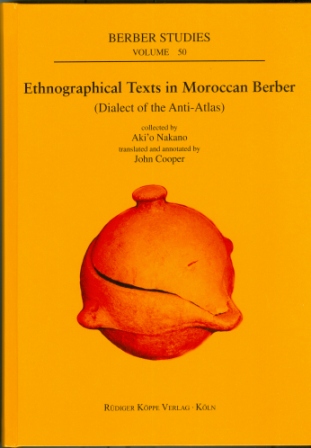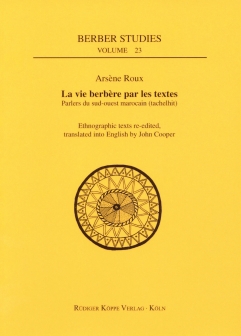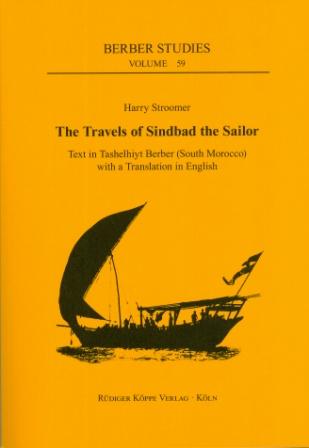


Ethnographical Texts in Moroccan Berber (Dialect of Anti-Atlas)
collected by Aki’o Nakano, translated and edited by John Cooper
Compiled by: Aki’o Nakano. Translated by: John Cooper. Annotated by: John Cooper. Edited by: John Cooper. In collaboration with: Ismail Ilsouk. With a preface by: John Cooper, Aki’o Nakano. Series edited by: Harry Stroomer.
Series: BS Berber Studies Volume 50
201726 pp. Roman, 379 pp.
2 maps, 92 colour photos, 30 b/w photos, index.
Text language(s): English
E-book
€ 98.00
Buy 'Ethnographical Texts in Moroccan Berber (Dialect of Anti-Atlas)' as a downloadable PDF document directly from our online shop »
The ethnographical texts in the Berber language of the southernmost region of the Atlas mountains in Morocco have been collected, transcribed, translated and annotated by the editors during the years from 1977 to 2015. The texts comprise the following topics:
1. Food: Life, breakfast, lunch, supper, light snack, meal, bread, porridge, potage, barley mash, maize mash, food made from roasted barley, couscous, grain of couscous, semolina, couscous and whey, couscous with turnip leaves, almond paste, milk / fresh butter / clarified butter, tea, coffee, stew meat, dish of chicken and eggs, tripes, liver and heart, feet, head, brain, canned fish, maize, broad beans, lentil, chick-peas and cow-peas, noodle, potato, onion, carrot, sweet pepper and hot pepper, eggplant, tomato, local salad, turnip, pumpkin, olives, garlic, baby’s foot, meal at a circumcision ceremony, meal at funeral, shepherd’s lunch, lunch in the field, worker’s lunch, meal at home, cigarette / tobacco / hashish, impure food, milk / bread / couscous.
2. Clothes: Women’s winter dress, women’s summer dress, night dress, long shirt, clothes worn at cultivation and harvest time, baby’s clothes, what men war on the head, what women and girls wear on the head, shoes, urban and rural dresses, men’s and women’s dress at the wedding, groom’s and bride's dress at the wedding, bag and dagger, shroud, coranic teacher’s clothes, worn out clothes, ornaments, chest box, ear-piercing, henna, kohl (mineral), hair, shamehair, mustache and beard, bath, washing of clothes, wool, loom, sewer on machine, diseases, popular medicament, serious wound or disease.
3. Habitation: Building of a house, our house in the country, sleeping room, small and large guest room, kitchen, room of barley and room of straw, toilet, rooftop, entrance, windows and doors, how to clean the house, hearth, baking oven, light, bushwood and firewood, place for firewood, charcoal, well, stone wall of the vegetable garden and the courtyard.
Further editions of Berber texts with English or French translation and ethnographic texts of Central and Southwest Morocco have been published in the same series:
Accompanying material:
- La vie berbère par les textes
(ISBN 978-3-89645-923-7 ) - Textes berbères des Aït Âyyache (la vallée d’Ansegmir, Midelt, Maroc) – Textes originaux avec traductions en français
(ISBN 978-3-89645-949-7 ) - Textes berbères des Ait Izdeg (Moyen Atlas marocain) – Textes originaux en fac-similé avec traductions
(ISBN 978-3-89645-939-8 ) - Textes berbères du Maroc central (Textes originaux en transcription)
(ISBN 978-3-89645-397-6 ) - Textes berbères du Maroc central (Traductions en anglais – Translations into English)
(ISBN 978-3-89645-943-5 )
Cross-reference:
- « Auréoles berbères »
(ISBN 978-3-89645-947-3 ) - « Parcours berbères »
(ISBN 978-3-89645-933-6 ) - An Anthology of Tashelhiyt Berber Folktales (South Morocco)
(ISBN 978-3-89645-381-5 ) - L’océan des pleurs
(ISBN 978-3-89645-998-5 ) - Tashelhiyt Berber Folktales from Tazerwalt (South Morocco)
(ISBN 978-3-89645-383-9 ) - Tashelhiyt Berber Texts from Ida u Tanan (South Morocco)
(ISBN 978-3-89645-388-4 ) - Tashelhiyt Berber Texts from the Ayt Brayyim, Lakhsas and Guedmioua Region (South Morocco)
(ISBN 978-3-89645-384-6 ) - The Berber Literary Tradition of the Sous
(ISBN 978-3-89645-999-2 ) - The Travels of Sindbad the Sailor – Text in Tashelhiyt Berber (South Morocco) with a Translation in English
(ISBN 978-3-89645-959-6 )
Reviews
One of the main objectives of the Berber Studies series is to publish linguistic and text-oriented studies. Many volumes are indeed dedicated to folktales collections, prose texts, included ethnographic and narrative material. The series also intends to publish data collected in the past, integrating them with translations or with further linguistic analysis. […]
The texts transcribed are in Tashelhiyt Berber, varieties spoken in South Morocco (High Atlas, Anti-Atlas, Sous plains). Other collections of texts from Morocco exist some of which were published in the Berber Studies series, as the textes berbères des Aït Âyyache by Lemkaden [sic] and Stroomer (2017) or Textes berbères des Ait Izdeg (Moyen Atlas marocain) by Mercier (2013), just to cite a few. The latter contains a translation that was not in the original, so its aim is very similar to the volume reviewed here. […]
The work John Cooper has carried out is not limited to the translation. As mentioned in the foreword, his fieldwork trips and the collaborative work with the speakers allowed him to verify the transcriptions by Nakano, correct typos or any misinterpretation and error that could have been caused by the fact that Nakano only consulted one person. Cooper’s footnotes also contain supplementary information given by his consultants, and cross-references to other texts (where the topic mentioned is analysed in more detail) or to photographs.
In conclusion, the volume is a valuable contribution to the study of the language and culture of the area. Through the translation, researchers who are not specialists in Berber can finally access these texts. The translation follows the Berber version as closely as possible, allowing for further linguistic analyses, even by those who are not specialists in Tashelhiyt. In addition, the accuracy of Afouche’s descriptions and the details he provides are invaluable for those interested in different cultural aspects of the area, also for those who want to compare it with similar data available from different Moroccan or North African Berber regions.
Valentina Schiattarella in Folia Orientalia, 57/2020, 175-176
| « back | Print version | [top] |
 Books
Books Audio
Audio Biographies
Biographies Series
Series Festschrifts
Festschrifts Journals
Journals